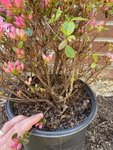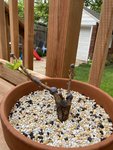You are using an out of date browser. It may not display this or other websites correctly.
You should upgrade or use an alternative browser.
You should upgrade or use an alternative browser.
Kanorin's "Azalea 2020-2025" entry
- Thread starter Kanorin
- Start date
Leo in N E Illinois
The Professor
- Messages
- 11,341
- Reaction score
- 23,294
- USDA Zone
- 5b
I like it.
Kanorin
Omono
Turned out there were 3 separate plants in the nursery container. Putting 2 of them into pots (1 for me, 1 for my 5 year old son). Took off some of the deep roots, removed most of the nursery soil and separated the plants.
My son chose this one to work with:
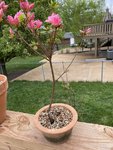
This one is for me. For the second trunk of the twin, should I keep trunk #1, #2, or #3?
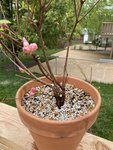
View a few degrees clockwise
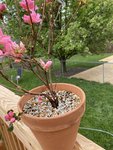
Thanks in advance!
My son chose this one to work with:

This one is for me. For the second trunk of the twin, should I keep trunk #1, #2, or #3?

View a few degrees clockwise

Thanks in advance!
Pitoon
Imperial Masterpiece
When you plan to cut back?
Kanorin
Omono
I haven't figured that out yet, does anybody have a recommendation? Right now I'm just enjoying the blooms.When you plan to cut back?
Leo in N E Illinois
The Professor
- Messages
- 11,341
- Reaction score
- 23,294
- USDA Zone
- 5b
The normal time for cut back is after 2/3rds of the flowers have been open a few days. Get the "Peak Bloom" photo, then it is time to remove all the flowers. All the unopened buds. Then you give the azalea a dose of fertilizer (normal strength, nothing stronger than normal). Then a few days later you repot and prune back. Since you already repotted, it is time to prune.
Satsuki azalea, and most azalea have a flush of vegetative growth right after blooming. You prune immediately after pruning to take advantage of this flush of new growth.
Then in late summer, early autumn, you go through and remove excess branches produced during the summer. At points were 3 or more branches come from one point, reduce to 2. Usually by autumn you will be able to feel or see the new flower buds for the next year. If the tree is in early phases of development you may want to remove some, so as to not tax the strength of the azalea. In a azalea being prepped for show, you can thin the number of buds if it seems excessive, or remove poorly placed buds.
So main time to prune & style azalea is either early spring, right after coming out of dormancy. Pruning before flowering means flower buds will be removed. But pruning at this time allows the whole growing season for recovery and development.
Second time for pruning is right after blooming has been finished. There is a flush of new growth that comes right after blooming, pruning at this time is good too.
Satsuki azalea, and most azalea have a flush of vegetative growth right after blooming. You prune immediately after pruning to take advantage of this flush of new growth.
Then in late summer, early autumn, you go through and remove excess branches produced during the summer. At points were 3 or more branches come from one point, reduce to 2. Usually by autumn you will be able to feel or see the new flower buds for the next year. If the tree is in early phases of development you may want to remove some, so as to not tax the strength of the azalea. In a azalea being prepped for show, you can thin the number of buds if it seems excessive, or remove poorly placed buds.
So main time to prune & style azalea is either early spring, right after coming out of dormancy. Pruning before flowering means flower buds will be removed. But pruning at this time allows the whole growing season for recovery and development.
Second time for pruning is right after blooming has been finished. There is a flush of new growth that comes right after blooming, pruning at this time is good too.
Leo in N E Illinois
The Professor
- Messages
- 11,341
- Reaction score
- 23,294
- USDA Zone
- 5b
The reason you remove the straggler blooms, shortly after 2/3rds the flowers have been open is that the flush of new growth that comes after blooming will start on the branches that were done first, and will be delayed on branches with late blossoms. By cutting off all the fading flowers and unopened buds, you put all the branches on the same timing, it is an energy balancing technique. It keeps the branches more in synch, for simultaneous blooming the next year. Removing spent blooms also prevents the development of seed pods. Blooms take energy, making seed takes more energy. You want the azalea to put energy into growth for next year rather than into making seed pods.
Kanorin
Omono
I did some hard pruning...not sure if I took off too much because I took off all except for 1 tiny flower leaflet.
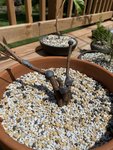
In the above image, I ultimately want to just keep the left trunk plus either the middle or the right trunk. I'd probably prefer to get rid of the middle trunk, but then I'm worried about a unsightly hole/knob where that trunk was removed. Will that mostly heal over within 4-5 years?

In the above image, I ultimately want to just keep the left trunk plus either the middle or the right trunk. I'd probably prefer to get rid of the middle trunk, but then I'm worried about a unsightly hole/knob where that trunk was removed. Will that mostly heal over within 4-5 years?
Leo in N E Illinois
The Professor
- Messages
- 11,341
- Reaction score
- 23,294
- USDA Zone
- 5b
That knob will need some carving to get rid of it, but you have done enough for the moment. Just let it grow now.
Kanorin
Omono
Pitoon
Imperial Masterpiece
Looking good!
Kanorin
Omono
...and now not looking good. I left it out in full sun over two days over 90 degrees and even though I watered it 2-3x per day, I think the young leaves couldn’t handle it. Crispified 

I’ve got it in the shade now, but I’m afraid it may not make it. All the leaves are brown and crisp to the touch. Any tips to help it pull through?

I’ve got it in the shade now, but I’m afraid it may not make it. All the leaves are brown and crisp to the touch. Any tips to help it pull through?
Harunobu
Chumono
Yeah, that looks pretty crisp. Does your substrate retain less water than say kanuma? Or are the brown pieces you do have kanuma? I don't know how continental your weather is, but I would think this wouldn't have happened if the substrate retained more water. With a pot that large and watering 2 to 3 times, it getting fried in early June, sounds like this is not the right substrate mix for an azalea. If the roots still have water, I wouldn't expect the leaves to go limp, then crisp, because of the intense sun. Unless of of course you move it from a moist shade immediately to a hot exposed spot.
Hard to say what it will do now. I never tried exactly this .
. I think the bud at the base is not completely fried yet? Wait, that's just a piece of rock greenish because of some algea on it. The odds of it still living are not zero. But even if it recovers very well, and likely you will get some dieback, you kind of lost a year competition-wise. Did all three of them fry?
I don´t know exactly the rules of the competition, but it may be a better bet to get a new plant and try again, competition-wise.
Hard to say what it will do now. I never tried exactly this
I don´t know exactly the rules of the competition, but it may be a better bet to get a new plant and try again, competition-wise.
Pitoon
Imperial Masterpiece
Sorry to see and hear that. If this one doesn't make it you have a back up to replace it?...and now not looking good. I left it out in full sun over two days over 90 degrees and even though I watered it 2-3x per day, I think the young leaves couldn’t handle it. Crispified
View attachment 307957
I’ve got it in the shade now, but I’m afraid it may not make it. All the leaves are brown and crisp to the touch. Any tips to help it pull through?
Kanorin
Omono
I think you're right about the substrate being at least part of the problem. It's a mix of about 45% pumice / 45% kiryu / 10% lava. My supplier was out of Akadama when I ordered soil components, so I thought the Kiryu would be similar. This year is also the first year that I'm mixing up my own soils from components (and I'm only 11 months into attempting bonsai in total) - so a lot to learn still. The kiryu is probably ok for my pines and junipers, but perhaps doesn't retain enough water for more thirsty plants.Yeah, that looks pretty crisp. Does your substrate retain less water than say kanuma? Or are the brown pieces you do have kanuma? I don't know how continental your weather is, but I would think this wouldn't have happened if the substrate retained more water. With a pot that large and watering 2 to 3 times, it getting fried in early June, sounds like this is not the right substrate mix for an azalea. If the roots still have water, I wouldn't expect the leaves to go limp, then crisp, because of the intense sun. Unless of of course you move it from a moist shade immediately to a hot exposed spot.
There are two other plants that came from the same 3 gal nursery can. The one I potted into a smaller pot never threw any new leaves after potting - it was potted in the same mix, so I suspect it dried out even faster being in a shallower pot. The third piece I put into the landscape in a full sun spot...it doesn't look great either, but that one might pull through.
Harunobu
Chumono
Azalea are thirsty plants. Especailly in full sun. But they also can't have wet feed. It is a bit of a paradox. I don't know how quickly these substrates dry out. But I know my kanuma takes more than a day to dry out in partial sun. I'd say you either need to go pure kanuma or mix in organic. And kiryu is acidic? Can't remember. Your azalea mix needs to 1) drain well, 2) be acid 3) retain water 4) be porous/airy to allow oxygen and roots to go through.
You kind of need 4 to be true for 1 and 2 to be true at the same time. If it drains well, but has no capillaries/increased surface area/pores, it won't retain water. And something can retain water without pores/capillaries, then it is some compacted organic soil stuff, and that won't drain well.
Ideally, an azalea has full morning sun but then partial shade the rest of the day. If they have enough foliage, shading itself, they could be placed n the full sun all day. Likely, their bark evaporates a lot more water than say a juniper and a pine. So if the sun is baking on azalea bark, that's not a good thing. They are dense scrubs in nature, so the bark doesn't need to protect against the sun, like it would on a tree.
You kind of need 4 to be true for 1 and 2 to be true at the same time. If it drains well, but has no capillaries/increased surface area/pores, it won't retain water. And something can retain water without pores/capillaries, then it is some compacted organic soil stuff, and that won't drain well.
Ideally, an azalea has full morning sun but then partial shade the rest of the day. If they have enough foliage, shading itself, they could be placed n the full sun all day. Likely, their bark evaporates a lot more water than say a juniper and a pine. So if the sun is baking on azalea bark, that's not a good thing. They are dense scrubs in nature, so the bark doesn't need to protect against the sun, like it would on a tree.
Leo in N E Illinois
The Professor
- Messages
- 11,341
- Reaction score
- 23,294
- USDA Zone
- 5b
Sorry to see this, things were looking pretty good back on May 28. I know your area's weather. Full sun in St. Louis is pretty hot. Hotter than in Japan or Netherlands, where Harunobu posts from. In the future, afternoon shade is best for your evergreen azaleas - the satsuki and kurume types used for bonsai. You can try setting the crispy one in full shade, give it 2 months, if it has not releafed out by then it truly is toast.
Your potting mix sounds too dry for Saint Louis heat. I would try to get Kanuma, rather than Akadama for your azaleas. If you are also growing maples or hornbeams or beech, Kanuma is acceptable for them. If most of your bonsai require Akadama, and you only have Akadama, you can use akadama. You don't have to go 100% of the Japanese "dirt", but you should get closer to 50%. IF I remember correctly Kiryu is a coarse river sand, so does not hold much water either.
You can also use a 25 to 50% bark & 50% pumice mix, or if you can find a peat that is not milled to a fine powder, you can use a sifted peat & pumice mix. IF you can get a hold of David Kreutz, he should have a good stock of Kanuma. He lives in the Saint Louis area, but he may be difficult to get a hold of.
I believe @Pitoon will allow you to substitute another entry for the contest, if you are still excited about the contest. Hope you stick with trying to learn azaleas, they are a rewarding group. They have a few quirks and demands that you have to learn, but all in all they are pretty easy to take care of once you figure out their quirks. Three azaleas are part of the 10 longest in my care trees. They are easy to keep going once you get the hang of them.
Your potting mix sounds too dry for Saint Louis heat. I would try to get Kanuma, rather than Akadama for your azaleas. If you are also growing maples or hornbeams or beech, Kanuma is acceptable for them. If most of your bonsai require Akadama, and you only have Akadama, you can use akadama. You don't have to go 100% of the Japanese "dirt", but you should get closer to 50%. IF I remember correctly Kiryu is a coarse river sand, so does not hold much water either.
You can also use a 25 to 50% bark & 50% pumice mix, or if you can find a peat that is not milled to a fine powder, you can use a sifted peat & pumice mix. IF you can get a hold of David Kreutz, he should have a good stock of Kanuma. He lives in the Saint Louis area, but he may be difficult to get a hold of.
I believe @Pitoon will allow you to substitute another entry for the contest, if you are still excited about the contest. Hope you stick with trying to learn azaleas, they are a rewarding group. They have a few quirks and demands that you have to learn, but all in all they are pretty easy to take care of once you figure out their quirks. Three azaleas are part of the 10 longest in my care trees. They are easy to keep going once you get the hang of them.
Kanorin
Omono
Thanks, Leo. I can feel that you are rooting for my little plant to pull throughSorry to see this, things were looking pretty good back on May 28. I know your area's weather. Full sun in St. Louis is pretty hot. Hotter than in Japan or Netherlands, where Harunobu posts from. In the future, afternoon shade is best for your evergreen azaleas - the satsuki and kurume types used for bonsai. You can try setting the crispy one in full shade, give it 2 months, if it has not releafed out by then it truly is toast.
Your potting mix sounds too dry for Saint Louis heat. I would try to get Kanuma, rather than Akadama for your azaleas. If you are also growing maples or hornbeams or beech, Kanuma is acceptable for them. If most of your bonsai require Akadama, and you only have Akadama, you can use akadama. You don't have to go 100% of the Japanese "dirt", but you should get closer to 50%. IF I remember correctly Kiryu is a coarse river sand, so does not hold much water either.
You can also use a 25 to 50% bark & 50% pumice mix, or if you can find a peat that is not milled to a fine powder, you can use a sifted peat & pumice mix. IF you can get a hold of David Kreutz, he should have a good stock of Kanuma. He lives in the Saint Louis area, but he may be difficult to get a hold of.
I believe Pitoon will allow you to substitute another entry for the contest, if you are still excited about the contest. Hope you stick with trying to learn azaleas, they are a rewarding group. They have a few quirks and demands that you have to learn, but all in all they are pretty easy to take care of once you figure out their quirks. Three azaleas are part of the 10 longest in my care trees. They are easy to keep going once you get the hang of them.
I'm glad that you, I and several other members above have all come to the same conclusion. When I try azaleas again, I'll make sure at least 50% of my mix is kanuma or some very highly water retentive substrate AND I'll give it some afternoon shade. Even the third azalea plant that I planted in the ground in full sun got all of it's leaves burnt off. The weather did do a very sharp turn from cloudy/rainy in the 60's and 70's, to 2-3 days in a row of full sun, 90+ degrees. I have 3 other azaleas in my landscape that get afternoon shade and they pulled through.
Maybe if I see an interesting azalea at when I go out to the stores this week I'll give it another shot, even if I'm just competing for honorable mention.
On the bright side, I think I've learned more about keeping azaleas in pots from having this plant die on me than if it had lived this season. Sometimes failure is a great teacher.
Harunobu
Chumono
While it does retain water, Kanuma is still substrate. To someone in a continental or Mediterranean climate, I would recommend 50% kanuma/50% coarse peat. Short term, that will let your tree survive the best. Maybe long-term for large mature bonsai, that much peat is too much? But for that I would talk to those that grow azalea bonsai in drier areas. Kanuma works so well in Japan because they have a summer rainy season. They would probably get root problems if they used 50% peat. Peat is just a great potting mix for any rhododendron. The issue it that over time it will start to compact. And with 'over time', I mean within a year.
I think sphagnum moss (the live non-composted form, not the peat) is sometimes mixed in with kanuma. That would be another option of putting in something organic that really retains water better than a substrate. If you have low humidity summers, water may very quickly evaporate from kanuma. It doesn't in Japan. It doesn't in other coastal temperate areas. But it probably does in continental or Mediterranean climates.
I still find that for normal azalea plants in horticulture-ideal pots, mixes with peat did best for me. Especially the growth you get initially is great. Then when winter and dormancy comes, it is not so great anymore. Peat is probably the best growth medium for rhododendorn. But it compacts within a year. I am thinking now a yearly repot for plants in peat may be best. I had a hard time finding coarse peat; they all mill it to dust, I don't know why. I liked the texture of coconut coir, but the pH is too high (6.5, though I never had bad short term results with it). There are some issues with coconot coir despite the pH being neutral and the pH potentionally getting even higher. And that is salts. They go coconut trees near the ocean and the salts are all supposed to have been washed away. But most azalea dislike high salts in their soil. So they don't grow well near the ocean (R.tamurae being the exception). So if there is still seasalt in the coir, that's a problem.
So I would consider experimenting with some organic component. If you can get fibrous or large pieces of organic material, I would add that. I even tried pine bark, but it decomposing a lot may be tricky for the soil chemistry. It does help things stay airy if you don't have kanuma or pumice or perlite.
I think sphagnum moss (the live non-composted form, not the peat) is sometimes mixed in with kanuma. That would be another option of putting in something organic that really retains water better than a substrate. If you have low humidity summers, water may very quickly evaporate from kanuma. It doesn't in Japan. It doesn't in other coastal temperate areas. But it probably does in continental or Mediterranean climates.
I still find that for normal azalea plants in horticulture-ideal pots, mixes with peat did best for me. Especially the growth you get initially is great. Then when winter and dormancy comes, it is not so great anymore. Peat is probably the best growth medium for rhododendorn. But it compacts within a year. I am thinking now a yearly repot for plants in peat may be best. I had a hard time finding coarse peat; they all mill it to dust, I don't know why. I liked the texture of coconut coir, but the pH is too high (6.5, though I never had bad short term results with it). There are some issues with coconot coir despite the pH being neutral and the pH potentionally getting even higher. And that is salts. They go coconut trees near the ocean and the salts are all supposed to have been washed away. But most azalea dislike high salts in their soil. So they don't grow well near the ocean (R.tamurae being the exception). So if there is still seasalt in the coir, that's a problem.
So I would consider experimenting with some organic component. If you can get fibrous or large pieces of organic material, I would add that. I even tried pine bark, but it decomposing a lot may be tricky for the soil chemistry. It does help things stay airy if you don't have kanuma or pumice or perlite.
Last edited:
Forsoothe!
Imperial Masterpiece
I'm really learning a lot about standard bonsai soil mixes.
Similar threads
- Replies
- 11
- Views
- 2K

